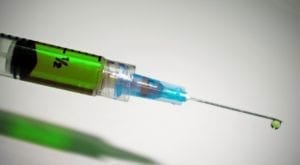Hypereosinophilic Syndrome (HES)
What is Hypereosinophilic syndrome (HES)?
Hypereosinophilic syndrome (HES) is a rare blood disorder characterized by a high level of eosinophils, which are white blood cells necessary for immune system function. The elevated eosinophils must be present for 6 months or longer and have no known cause to be classified as HES. HES is more common in men than women and usually appears between the ages of 20 and 50. It is roughly estimated that 1 to 2 people per 1 million have HES.What are the symptoms of HES?
The high level of eosinophils causes organ damage throughout the body, so the symptoms of HES are related to the organs affected and can vary in severity. Common areas affected include skin, heart, lungs, nervous system, and bone marrow. Symptoms of HES include:- Skin rashes and lesions
- Heart disease and heart failure
- Lung disease that includes blood clots, inflammation, cough and shortness of breath.
- Fever and night sweats
- Fatigue
- Memory loss
- Brain damage
- Nerve damage in extremities
- Diarrhea
What causes HES?
The exact cause of HES is unknown. HES is diagnosed when all other reasons for the elevated eosinophils are ruled out. Research is being done to determine the exact cause. An emerging theory is that there is an inherited genetic cause.Are there treatment options available for HES?
Treatment of HES is directed at lowering the number of eosinophils and avoiding organ damage. Treatment varies in each individual based on symptoms and severity. In some cases, if untreated, HES can be fatal. Treatments include:- Steroids such as prednisone to decrease inflammation and symptoms
- Interferon alpha is an injectable medication given to suppress symptoms
- Gleevec is a tyrosine kinase inhibitor. This medication has been developed to treat individuals with a known genetic cause for HES
- Chemotherapy agents are used in severe cases to lower the level of eosinophils
Where can I find more information about HES?
Hypereosinophilic Syndrome (HES) Articles

Nucala is Now Approved For 4 Rare Eosinophil-Based Diseases in Europe
Trudy Horsting
December 6, 2021
Read More »


Hypereosinophilic Syndrome Has First FDA Approved Therapy in 14 Years
Sunniva Bean
October 12, 2020
Read More »

Editor’s Choice: Can Machine Learning Help Rare Patients Get Diagnosed and Treated Faster?
Colby Rogers
October 9, 2020
Read More »


Nucala Granted Priority Review as Possible Biologic Treatment For HES
Sunniva Bean
June 9, 2020
Read More »

Nucala Granted Priority Review For Treatment of Hypereosinophilic Syndrome
Jessica Lynn
June 3, 2020
Read More »

Eosinophilic Asthma Treatment Nucala has FDA Approval Expanded to Children Aged 6 to 11
Scott Carlson
September 20, 2019
Read More »



